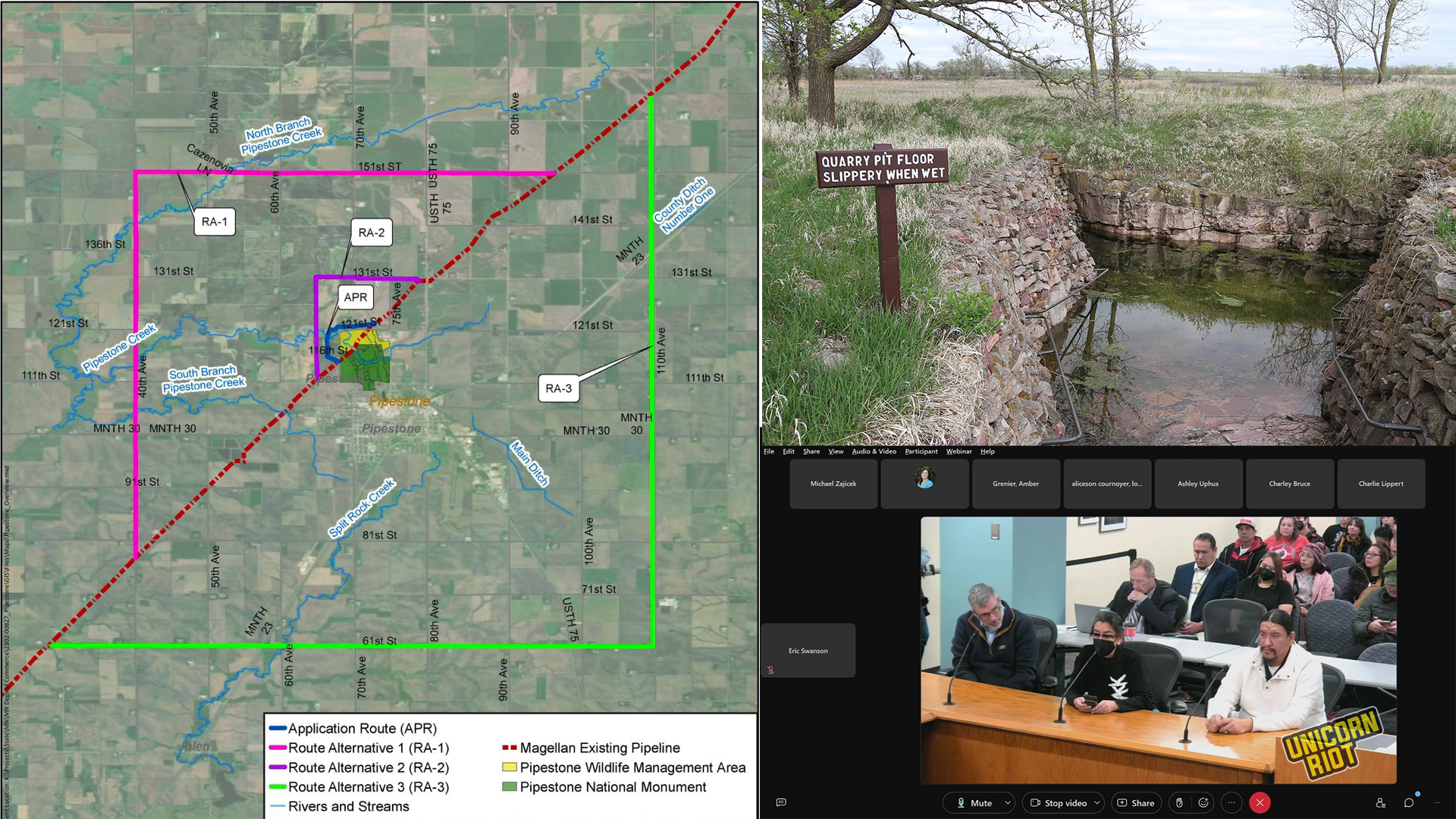Permit for Pipeline Reconstruction Near Sacred Pipestone Site Rescinded After Tribal Pushback
St. Paul, MN — Following sustained opposition from Indigenous nations, community groups, and environmental advocates, Minnesota regulators rescinded a controversial permit that would have allowed Magellan Pipeline Company to reconstruct a petroleum pipeline near the Pipestone National Monument, a sacred resource to tribes conducting ceremony. The decision was made during a January 2025 Minnesota Public Utilities Commission (PUC) public hearing which requires Magellan to conduct full cultural, archaeological, and historical surveys before reapplying for a permit.
Due to inadequate tribal consultation and an incomplete cultural and archaeological survey of the land, the PUC voted unanimously to revoke the route permit, which was granted just months ago in Oct. 2024. The RA-01 pipeline route, a 13.1 mile-long alternative route proposed by the Mille Lacs Band of Ojibwe, is the new favored route due to the distance around Pipestone.
The PUC ordered Magellan to conduct comprehensive surveys of all the remaining route alternatives and coordinate with Indigenous nations to address any concerns before submitting their new permit application.
Tribal Advocacy and Sacred Lands at Risk
The Pipestone National Monument was founded in 1937 with the consultation of tribal community members to protect the natural resources. It is a site where Indigenous peoples actively perform ceremonies such as the pipe ceremony and where tribal nations have gathered catlinite for thousands of years. Catlinite, or pipestone, is a red-brown, clay-like mudstone that is soft enough to be cut with a knife. The stone is used to make sacred tobacco pipes.
In 1858, the Yankton Sioux Tribe signed the Yankton Sioux Treaty with the U.S. government, which ceded over 11 million acres of South Dakota, making way for Minnesota to become a state. Even with the massive loss of land, there’s an article in the treaty which gives the tribe “the free and unrestricted use of the red pipe-stone quarry” inside that area of land. However, it took the tribe 79 years of fighting for their rights to have the “free and unrestricted” access they were supposed to have from the treaty.
A letter sent to the PUC in late December 2024 from Samantha Odegard, the Tribal Historic Preservation Officer for the Upper Sioux Community, highlighted the tribes’ opposition to the pipeline, “our stance has consistently been one of firm opposition to any pipeline that poses a risk to the sacred stone, cultural sites, and landscape that has been revered for millennia,” and added that the participation of mitigation should not be seen as condoning the project.
Faith Spotted Eagle, who leads the Brave Heart Society, highlighted the project’s risks to the sacred site and its resources. The letter states that the pipestone is scarce and confined to a narrow zone of just 11-18 inches thick, which makes the need for federal intervention that much greater. “Archeological evidence proves that the pipestone has been quarried by the Indigenous tribes of North America for at least 3,000 years,” the Society said.
Cultural Surveys and Land Access Challenges
Discussions during the PUC hearing revealed three phases needed for upcoming cultural surveys, which include a desktop analyses, field inspections to identify potential pipestone-concentrated sites, fieldwork requiring access to private property, and mitigation strategies implemented if anything culturally significant is discovered.
Getting permission from land owners for some of the fieldwork was noted as a potential challenge, which Magellan acknowledged. For the fieldwork itself, tribal representatives pushed to ensure qualified consultants are knowledgeable about the culture and to ensure surveys address tribal concerns.
The Brave Heart Society stressed the importance of making sure survey teams understand the area holds cultural significance, and also recommends the Minnesota Indian Affairs Council and State Historic Preservation Officer get special training on pipestone and that the contractor selection be overseen by tribal representatives.
Permit Rescission and Next Steps
The new permit process now requires Magellan to conduct full cultural, archaeological, and historical surveys for routes RA-01 and RA-03, excluding RA-02, the 3.4 mile-long route proposed by the Magellan Pipeline that is closest to Pipestone National Monument.
Magellan must coordinate with tribal nations in selecting consultants and reviewing survey results at every stage of the process and provide compliance filings detailing survey findings and consultations before the PUC makes any final decisions.

During the PUC hearing, Debra Topping, a member of the Fond du Lac Band of Lake Superior Chippewa, spoke against route RA-01, saying, “I do not believe that [RA-01] would be adequate. It’s too close to the monument.”
Faith Spotted Eagle of the Brave Heart Society stressed the importance of all 23 federally recognized tribes connected to Pipestone National Monument being engaged in the process. Public letters and petitions — over 180 submitted — repeatedly called for removing routes near the monument.
Reflections on the need for stronger engagement with the public and tribal nations were stated by PUC commissioners. Commissioner Hwikwon Ham acknowledged past errors, saying, “When they spoke in unison voice, we have to pay additional attention. This is not just about efficiency, but about building trust and relationships with tribal nations.”
A regular visitor to Pipestone to get stone to craft tobacco pipes, Jason Chauska Sharp, drove from St. Cloud with his father to attend the hearing and underscored the broader struggle to protect sacred spaces, saying, “We’ve already lost so much as tribal people.”
As the PUC reevaluates the pipeline project, tribal and public voices remain central to shaping its outcome.
Editor’s Note (2.13.25): This article has been re-edited to reflect Unicorn Riot’s editorial standards.
Follow us on X (aka Twitter), Facebook, YouTube, Vimeo, Instagram, Mastodon, Threads, BlueSky and Patreon.
Please consider a tax-deductible donation to help sustain our horizontally-organized, non-profit media organization:



